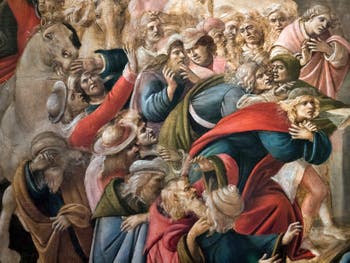Uffizi Artists | Location | Opening Hours Tickets | Authorizations
Artists Botticelli | Michelangelo | Da Vinci | Caravaggio | Raphael | Titian | Giorgione | Medici | Dürer Cranach Memling | Credi Bartolomeo | Rubens
Botticelli Spring | Venus | Pallas | Calumny | Judith | Augustine | Young Man | Magi Novella | Magi (1500) | Annunciation Cestello | Annunciation Martino | Madonna Pomegranate | Coronation Virgin | Madonna Magnificat | Madonna Enthroned | Madonna Glory | Madonna Rose | Madonna Saints
Botticelli “The Adoration of the Magi, 1490-1500” at the Uffizi Gallery in Florence
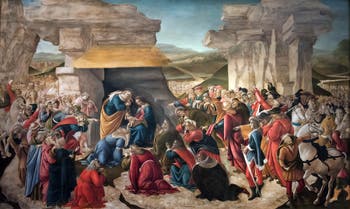
Adoration of the Magi Tempera on wood (108x174 cm) 1475-1477
This spectacular “Adoration of the Magi”, more than 80 characters besides the groups of riders in the distant, is one of Botticelli's most complete paintings.
The attitudes, the faces, the intelligence with which Botticelli managed to contain so many characters in space, to organize them in the apparent disorder of a crowd in delirium, ecstasy, makes it one of the most complete and successful works of this genius artist.
Colours... added
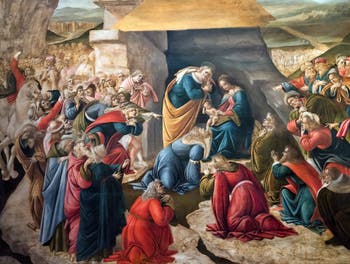
The Adoration of the Magi However, it should be emphasized that the colours are not of Botticelli itself, the original painting is a tempera on monochrome wood of sepia tint.
The current colours of the painting were painted in oil over Botticelli's original painting by one or more unknown painters between the 16th and 17th centuries.
Some parts of the painting, however, remained the same as the groups of riders and horses of sepia colour that were happily preserved.
Even if the characters have been coloured, Botticelli's creative power remains particularly present in this beautiful painting because it seems that for the most part, their features have been respected due to their original sepia tint which is still that of the vast majority of them.
A dating heavy with meanings
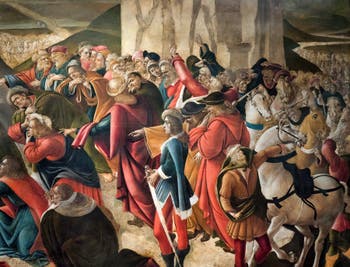
The Adoration of the Magi The date of completion is uncertain. For some, the painting would have been made before Botticelli left for Rome in 1481.
For others, and this is the date officially chosen today by the Uffizi Gallery itself, the painting would have been made between 1490 and 1500.
This distinction is more important than it seems.
Because it was on May 23, 1498, that Jerome Savonarola was executed in Piazza della Signoria after having managed to convey his ideas to a large part of the Florentine elite.
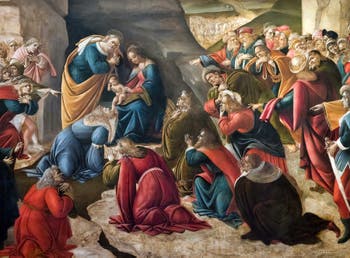
The Adoration of the Magi Botticelli was one of those to be heavily influenced by Savonarola's ideas as well as Pico della Mirandola or Angelo Poliziano.
If this “Adoration of the Magi” was painted by Botticelli between 1490 and 1500, as it is now dated by the Uffizi Gallery in Florence, it takes a very different meaning from that of 1475-1477 which glorified the Medici dynasty.
It should be noted, first of all, that there are no more three kings kneeling here, but... eight!
According to some, we must recognize here the eight leaders of the Florentine Lordship, of the Republic of Florence, kneeling and prostrate before Jesus, “Christ the King of Florence” according to the theory of Savonarola.
Jerome Savonarola and Lorenzo the Magnificent
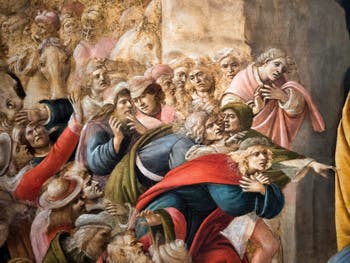
The Adoration of the Magi This dating between 1490 and 1500 would also explain the presence of the two characters to the left of Joseph, who would be no other than Jerome Savonarola and Lorenzo Medici.
Savonarola, the spiritual master of Botticelli, on the one hand, and Lorenzo the Magnificent, his protector and prince on the other, united before the Child Jesus.
The way these two characters stand is unique in this painting, the second being totally wrapped up, enclosed in the cloak of the first, is not explained otherwise.
Savonarola shows Christ with hand to Lorenzo the Magnificent, as did Pic della Mirandola in the Adoration of the Magi of 1475-1477.
A gesture with profound meaning: Savonarola thus indicates to Lorenzo the Magnificent that one can only have faith in God who is the only sovereign: “Rex Regnum, Dominus dominantium”.
And Lorenzo the Magnificent, obeys him by standing in an attitude of supplication to Jesus.
Leonardo da Vinci in Botticelli's Adoration of the Magi
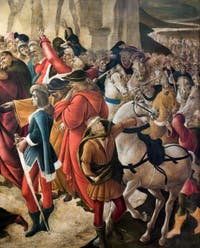
The Adoration of the Magi A third important character would be represented according to some critics in this Adoration of the Magi: Leonardo da Vinci.
In the right part of the painting, one can see, positioned between the character dressed in blue and the horses that are pounding, a tall and dignified man, dressed in a red cloak, straight, calm, attentive and concentrated, in opposition to the crowd around him, Sandro Botticelli's friend: Leonardo da Vinci.
It is clear that the three portraits present here, of Savonarola, Lorenzo the Magnificent and Leonardo da Vinci, have the features that are known to them in other portraits depicting them.
Three characters whom all had a very important role in Botticelli's life and career.
“I will glorify the House of my glory.”
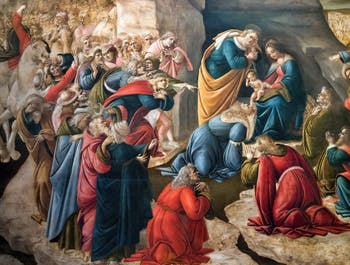
The Adoration of the Magi This Adoration of the Magi is a perfect illustration of the text of Isaiah (60:3-7), a text read during Mass on the Day of Epiphany:
“The nations walk in your light, and the king in the light of thy dawn, Look up around and see:
all come together, they come to you,
your sons come from afar,
And your daughters are worn on your hip.
Then, at that sight, you'll be radiant,
your heart will shudder and dilate;
for the treasures of the sea will go to thee,
the riches of the nations will come to you.
The Adoration of the Magi Streams of camels will cover you,
of the camels of Madian and Ephah;
all these shall come from Sabah,
they will bring gold and incense
and publish the exploits of Yahweh.
All the flocks of Quedar shall gather at thee,
the rams of Nebayot will be at your service,
they shall go up, to be approved, on my altar,
And I will glorify the House of my glory.”
A dense and restless crowd
It is a crowd identical to that of Isaiah, dense with waves, not camels, but horses, heading from three distinct roads to the crib and the Child Jesus, in an ardour, communicative euphoria, conscious, moved by the grandiose event.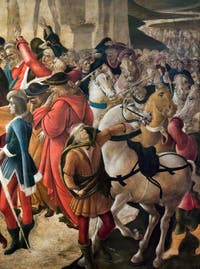
The Adoration of the Magi The horses are just as agitated, kicking, rearing up, from those at the bottom of the painting to those in the foreground.
An intense emotion is read on all the faces of this crowd where we only see men.
Some seem to be delirious, ecstasy, prostrate, frantic, tormented as in the Adoration of the Magi of Leonardo da Vinci, bent bodies that flow forward, arms raised, as if some were to protect their eyes from too strong light, as if they were dazzled, while others burst into sobs.
In sobs like the “Piagnoni”, as were designated the disciples of Savonarola, the “weeping” so called because of their supplications and penances, in opposition to the “Arrabiati”, the “angry” who represented those who were opposed to the ideas of Savonarola.
Supplication, agitation and gesticulation, of praying hands, hands that show, hands erect at the end of arms that twist: The response to Jerome Savonarola's preaching resonates amply in this Adoration of the Magi of Botticelli.
Celestial Sphere
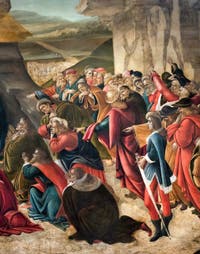
The Adoration of the Magi And yet, no divine light, no stars in this painting of the Adoration of the Magi.
The only reference to light is the yellow roof of the crib, a “false” reference when it is known that this painting was originally monochrome, sepia, before being coloured by another artist than Botticelli.
An absence due to the state of sketch, project of an unfinished table? Or a divine light that “guesses” itself without the need to be represented? Or would the three-pointed star be represented by the three paths through which this crowd of men and horses arrives?
We have no answer to this absence.
But the celestial sphere is well present in the midst of human agitation.
Joseph, the Virgin and Child Jesus are “out of time”, calm, soothed and collected, detached from everything that happens around them, their attention being limited to the first of the wise men kneeling before Christ by kissing his foot.
Botticelli Spring | Venus | Pallas | Calumny | Judith | Augustine | Young Man | Magi Novella | Magi (1500) | Annunciation Cestello | Annunciation Martino | Madonna Pomegranate | Coronation Virgin | Madonna Magnificat | Madonna Enthroned | Madonna Glory | Madonna Rose | Madonna Saints
Artists Botticelli | Michelangelo | Da Vinci | Caravaggio | Raphael | Titian | Giorgione | Medici | Dürer Cranach Memling | Credi Bartolomeo | Rubens
Uffizi Artists | Location | Opening Hours Tickets | Authorizations
Back to Top of Page


